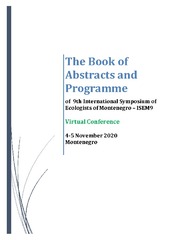Приказ основних података о документу
Microcosm approach: In situ effects of microplastic mixture on community structure of freshwater benthic macroinvertebrates
| dc.contributor | Pešić, Vladimir | |
| dc.creator | Stanković, Jelena | |
| dc.creator | Stojković Piperac, Milica | |
| dc.creator | Jovanović, Boris | |
| dc.creator | Savić-Zdravković, Dimitrija | |
| dc.creator | Raković, Maja | |
| dc.creator | Petrović, Ana | |
| dc.creator | Milošević, Đurađ | |
| dc.date.accessioned | 2021-02-03T11:31:51Z | |
| dc.date.available | 2021-02-03T11:31:51Z | |
| dc.date.issued | 2020 | |
| dc.identifier.isbn | 978-9940-798-00-0 | |
| dc.identifier.uri | https://radar.ibiss.bg.ac.rs/handle/123456789/4108 | |
| dc.description.abstract | Benthic communities represent one of the most threatened organisms in aquatic habitats due to accumulation of plastic particles in sediments. High abundance of MPs in aquatic habitats indicate higher probability of macroinvertebrates to ingest microplastic particles. Benthic community was exposed to high concentration of MPs, 80 g m-2 in sediment, and control, without addition of MPs. Mixture of MPs contained polyethylene (PE), polyvynil-chloride (PVC) and polyamide (PA) in a ratio of 50%: 25%: 25%, respectively. In situ experiment lasted for 100 days. Total number of taxa that colonized the trays were 22 (17 in control, 18 in HC treatment). Most dominant group within macroinvertebrate community was dipteran family Chironomidae, both in control and HC treatment. No significant differences in abundance and biomass at community level between control and HC treatment was recorded by PERMANOVA ((F=0.993; p=0.456 and F=0.344; p=0.797, respectively). Mixture of microplastics did not influence abundance and biomass of functional feeding groups within macroinvertebrate community (F=1.810; p=0.137 and F=0.377; p=0.736, respectively). Species richness (S), species abundance (N), biomass (B), Shannon's diversity index (H) and Simpson's index (D) showed no statistically significant differences between the control and treatment groups. | sr |
| dc.language.iso | en | sr |
| dc.publisher | Podgorica, Montenegro: Institute for Biodiversity and Ecology | sr |
| dc.rights | openAccess | sr |
| dc.source | 9th International Symposium of Ecologists of Montenegro – ISEM9 Virtual Conference 4-5 November 2020 Montenegro | sr |
| dc.subject | Microplastics | sr |
| dc.subject | Macroinvertebrates | sr |
| dc.subject | Benthic community | sr |
| dc.subject | Functional feeding groups | sr |
| dc.subject | Microsocms | sr |
| dc.title | Microcosm approach: In situ effects of microplastic mixture on community structure of freshwater benthic macroinvertebrates | sr |
| dc.type | conferenceObject | sr |
| dc.rights.license | ARR | sr |
| dcterms.abstract | Раковић, Маја; Станковић, Јелена; Стојковић Пиперац, Милица; Јовановић, Борис; Савић-Здравковић, Димитрија; Петровић, Aна; Милошевић, Ђурађ; | |
| dc.rights.holder | © 2020 Institute for Biodiversity and Ecology | sr |
| dc.description.other | Pešić V, editor. 9th International Symposium of Ecologists of Montenegro – ISEM9: Virtual Conference: Book of Abstracts; 2020 Nov 4-5, Montenegro. Podgorica, Montenegro: Institute for Biodiversity and Ecology; 2020. p. 23 | sr |
| dc.citation.spage | 23 | |
| dc.type.version | publishedVersion | sr |
| dc.identifier.cobiss | 15453444 | |
| dc.identifier.fulltext | https://radar.ibiss.bg.ac.rs/bitstream/id/8124/Stankovic-et-al.pdf | |
| dc.citation.rank | M34 | |
| dc.identifier.rcub | https://hdl.handle.net/21.15107/rcub_ibiss_4108 |

